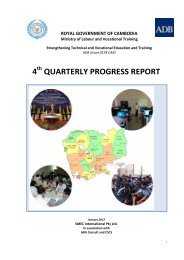Strengthening Technical and Vocational Education and Training ...
Strengthening Technical and Vocational Education and Training ...
Strengthening Technical and Vocational Education and Training ...
Create successful ePaper yourself
Turn your PDF publications into a flip-book with our unique Google optimized e-Paper software.
Supplementary Appendix G 45<br />
o Are the criteria for ‘formal’ <strong>and</strong> ‘non-formal’ training the same as the criteria for<br />
distinguishing ‘formal’ <strong>and</strong> ‘non-formal’ businesses?<br />
In the example above, VETMIS needs a decision, whether ‘non-formal’ is an attribute of (i)<br />
the method of training delivery (ii) the type of certification that is issued at the end of a<br />
course, (iii) the length of the training course or (iv) the qualification of the training provider<br />
who delivers the training course. Currently, it seems that the length of a course is the only<br />
criterion for judging the courses skill level.<br />
St<strong>and</strong>ard Formats for Surveys<br />
Between 1993 <strong>and</strong> 2000 <strong>Training</strong> evaluation needs assessments (TENA) were conducted<br />
<strong>and</strong> staff were trained using formats <strong>and</strong> processes developed by ILO.<br />
<strong>Training</strong> needs analyses were also conducted under ESDP II for the voucher program<br />
(VSTP) <strong>and</strong> are still being conducted by the ECOSORN project in the north west of<br />
Cambodia 31 .<br />
Based on the results of these activities <strong>and</strong> using lessons learnt, st<strong>and</strong>ards should be<br />
developed for regular tracer studies <strong>and</strong> for regular surveys of training needs 32 .<br />
St<strong>and</strong>ardization will allow capturing the results of the surveys in VETMIS. And this will allow<br />
producing statistics <strong>and</strong> analysing <strong>and</strong> interpreting the results of the surveys (see activity<br />
1.2.4.b page Error! Bookmark not defined.). Models for st<strong>and</strong>ard questionnaires are<br />
presented in annexe 12, 13 <strong>and</strong> 15. St<strong>and</strong>ardization will also include the processes <strong>and</strong><br />
procedures to be used during <strong>and</strong> after the surveys, which procedures will be documented<br />
<strong>and</strong> included in the Management H<strong>and</strong>book for VET institutions (see activity 1.2.7.c – page<br />
Error! Bookmark not defined.)<br />
St<strong>and</strong>ardization <strong>and</strong> Harmonization of MoLVT Data<br />
Each department <strong>and</strong> office within MoLVT collects <strong>and</strong> keeps data in different formats <strong>and</strong><br />
dimensions. Data about employers, for example, is kept in different formats <strong>and</strong> different<br />
dimensions in the following departments:<br />
o Department of Labour Inspection<br />
o Department of Work Conflict<br />
o Department of Occupation <strong>and</strong> Manpower<br />
The purpose of activities 1.2.4.a through 1.2.4.c (page Error! Bookmark not defined.) is to<br />
harmonize <strong>and</strong> st<strong>and</strong>ardize data within MoLVT. Keeping in mind that a full st<strong>and</strong>ardization is<br />
outside the scope of the project, only basic data that is relevant for VETMIS <strong>and</strong> LMIS will be<br />
targeted by this activity. The result will be that relevant data from within MoLVT will be<br />
directly available for the purposes of VETMIS <strong>and</strong> LMIS. This will avoid duplications of the<br />
collection of same data by various departments.<br />
ICT Equipment <strong>and</strong> ICT Skills<br />
During the field visits (see Annex 2) <strong>and</strong> through a survey (see questionnaire Annex 3) a<br />
definite need for ICT equipment in all offices was identified. It also emerged that the officers<br />
in PTCs <strong>and</strong> at MoLVT lack basic ICT skills. The gap between the existing ICT situation <strong>and</strong><br />
the required ICT infrastructure <strong>and</strong> ICT skills will widen if provincial institutions become<br />
agencies of the planned National Employment Agency. Transforming PTCs into offices of<br />
NEA will increase the need for a better ICT infrastructure <strong>and</strong> ICT training of more staff.<br />
31 http://www.ecosorn.org/<br />
32 The recommendation in sections 28 <strong>and</strong> 29 of the final report of the Basic Skills program was to conduct TENA<br />
regularly, to regularly update the training <strong>and</strong> employment needs of the country <strong>and</strong> to regularly conduct tracer<br />
studies on learning outcomes.





